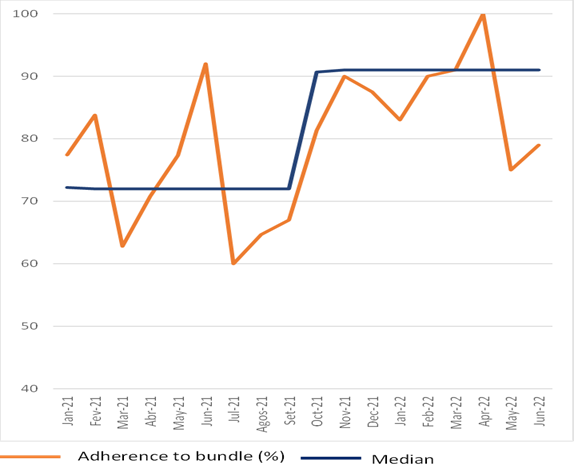Why It Matters
Used together, tools for early detection and treatment ensure timely care of patients with established or imminent critical illness. MEOWS (Modified Early Obstetric Warning Score) is a system to identify patients at risk of complications related to pregnancy and birth based on vital signs, derived from systems initially developed by Morgan and Wright. Nurses collect vital signs from patients, including heart rate, blood pressure, temperature, and breathing rate. They then manually calculate the MEOWS score using a reference table. Providers then deliver the appropriate bundle of care, a set of up to five evidence-based interventions.
Two health facilities in Memba District, Mozambique, successfully implemented the MEOWS system as part of a Collaborative in the Alcançar project, a USAID-funded project working in Nampula and Zambezia Provinces to reduce maternal and neonatal mortality. Teams are testing care bundles to prevent and control maternal bleeding (hemorrhage), seizures (eclampsia), and infection (puerperal sepsis), as well as protective care and breathing support for newborns. For example, interventions for eclampsia include administering medication to lower blood pressure and assessing fetal and maternal health.
Memba is a rural district with a population of about 367,000 where 94 percent of deliveries happen in health care facilities. Through the Alcançar project, the District Chief Physician, Pedro Mazembe, received training as an Especialista em Melhoria (Improvement Advisor) and volunteered to test the use of MEOWS with care bundles at Memba Health Center (11 obstetric beds with about 90 deliveries per month) and Memba District Hospital (15 obstetric beds with about 80 deliveries per month). He met with the nurses to present the proposal and to provide training. Initially, the team tested the system in a single shift, applying it to patients with hypertension and identifying what treatments were necessary. With the success of the test, the team gradually expanded use of the system to the entire service. As Chief Physician, Mazembe monitors the medical records for adherence to the MEOWS system.

Use of the bundle of care for preeclampsia and eclampsia increased across the Collaborative in Memba District, Nampula Province, Mozambique.
Mazembe said, “In July, there were four cases of postpartum hemorrhage at the health center. Two patients received follow-up care at the health center and two others arrived at the district hospital after they were in uterine atony [a complication that can cause dangerous blood loss and requires intervention] and ended up in the operating room and the vital signs were evaluated using the MEOWS tool.” As a result, the team delivered necessary care and all four patients eventually had positive health outcomes. In addition, Mazembe observed the team preventing potential cases of infection, seizures, and heavy bleeding through monitoring and treatment. He added, “The student nurses’ [use of the appropriate interventions] is all well underway, following MEOWS in detail.”
Lessons Learned
- Start small. Knowledge of Plan-Do-Study-Act cycles made it possible for the team to test MEOWS in a single shift, with a specific group of patients before slowly spreading to other areas.
- Work as a team. The Chief Physician trained the nurses in use of MEOWS and involved them in the testing process.
- Be proactive. The team highlights that they no longer wait for a patient’s health to worsen before acting. They reflect on stories of patients that they were able to treat before their condition grew more serious by using MEOWS.
The team faces ongoing challenges, such as a lack of supplies and medications and understaffing. They work to maximize use of existing resources. One heart monitor in the facility was underused due to a lack of batteries. Because monitoring heart rate is a necessary component of the MEOWS score, the team was able to advocate for the restocking of batteries.
Through the continuous monitoring of critically ill patients, the recording of vital signs in medical records, and the appropriate identification and treatment of complications, the team has been highly effective in improving patient care.
Kelly Rosenfeld is a Project Manager at IHI. Jacqueline Torres, PhD, RN, CNM, IA, is IHI Faculty and Technical Director of the Alcançar Project.
